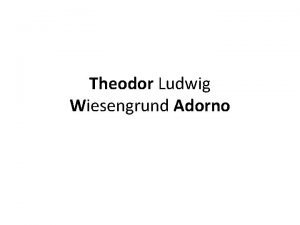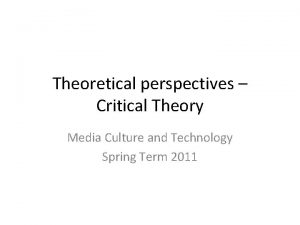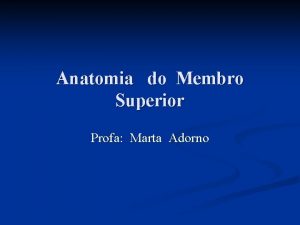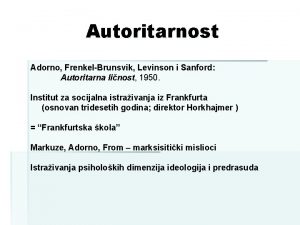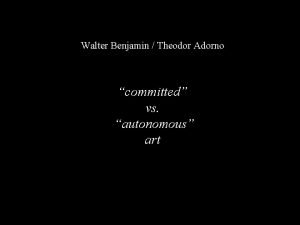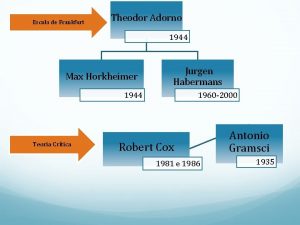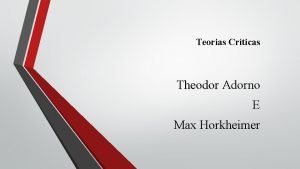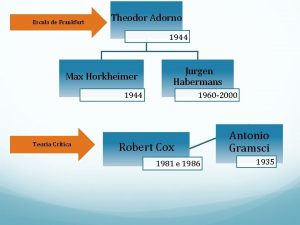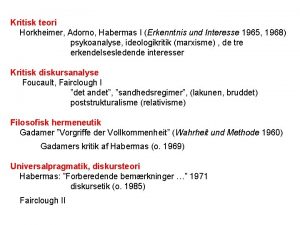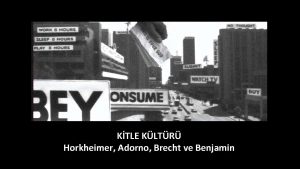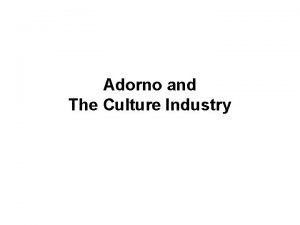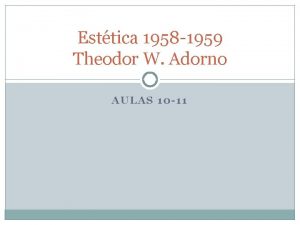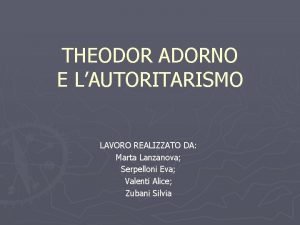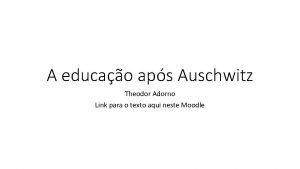Max Horkheimer Theodor W Adorno The Cultural Industries












- Slides: 12

Max Horkheimer & Theodor W. Adorno: The Cultural Industries Lecture, Popular Culture & Medieforskningens klassikere

Immediate context Written in USA, 1943 -44, Santa Monica Part of the unfinished “Dialectics of Enlightenment” Intended to be a summation of the Frankfurt school’s work in philosophy and social theory

Institutional context: The Frankfurt school Institut für Sozialforschung 1923, Columbia University from 1935, reestablished in Frankfurt 1953, operative until 1960 s Dominant core in Horkheimer, Adorno, Herbert Marcuse, Leo Löwenthal. Periphery: Walter Benjamin A version of Marxism: conflict model of society, revolution versus reaction. Critique of "objective progress", foci on aesthetics and social psychology

Key issues in the critical understanding of inter-war society • The tensions between democracy and authoritarianism • The swing from revolutionary tendencies toward reactionary developments • The rise of industrialism: fordism, taylorism • The industrialisation of culture • The fear of propaganda through mass communication • A/H: "How to reconcile the current with the possible"

Obstacles to understanding the "Cultural Industries" essay • The culture industry essay is a fragment of a fragment • The fragment genre: thought under way, partial insights real, total ones not • Tendencies toward genre mixture; the logical/strictly rational argument mixed with polemics, hyperbole and satire • No attempt at analytical proof or correction • In sum: needs to be read as experimental and manyvoiced prose

Exemplary passage “A technical rationale is the rationale of the domination itself. It is the coercive nature of society alienated from itself. Automobiles, bombs and movies keep the whole thing together until their leveling element shows its strength in the very wrong which it furthered. ”

Commentary to the passage Sweeping, generalising statements rather than strictly logical propositions Juxtapositions of disparate phenomena Central paradox: exposure of a wrong strengthens that very wrong (contrary to the uncovering logic of critique) General thesis: enlightenment turns into mass deception

The notion of enlightenment as mass deception in historical context Critique of industrial society: production for general welfare turns into the manipulation of working life Critique of bureaucracy: decision-making by formal procedure turns into a way of legitimising de-humanisation Critique of antidemocracy: the appeal to regressive emotionality

How the cultural industries turn rationality against itself CI rhetoric: Nothing is at stake because the cultural industries are “only entertainment” and addressed to an actual felt need However CI frustrates people’s real needs by promising without delivering and by sabotaging any attempt at critical distance from immediate satisfaction By the same token CI suppresses the less saleable, more demanding logics that underlie authentic art

Philosophical underpinnings I “The general and the particular”, “totalisation” H/A: the “false union between the general and the particular”. This includes: · subordinating the subjective under the objective ("what people really want") ·subordinating parts under a whole (zero tolerance for contradiction) · subordinating the accidental to the planned (factory line logic replaces individuality)

Philosophical underpinnings II “Quantity” and “quality” H/A: “the qualitative becomes quantitiative”. · Exchangeability: sameness in basic structure · Stereotyping: all popular culture simplifies and caricatures · The “pseudo-new”; novel on the only surface

Intellectual/academic critique of H/A The elitism charge: H/A as defenders of modernism against mass culture The charge of an ignorance of actual popular culture: Adorno as jazz hater The charge of ignoring reception: H/A tend to consider the audience as an “adjunct to the machinery” The charge of simplifying the production of culture: reliance on tendencies of monopolisation and conveyor belt production The charge of overemphasising culture: does culture shape mentalities to the extent that H/A seem to imply?
 Objetivos de la escuela de frankfurt
Objetivos de la escuela de frankfurt Theodor ludwig wiesengrund adorno
Theodor ludwig wiesengrund adorno Theodor adorno beatles
Theodor adorno beatles Mass media
Mass media Bulk reducing examples
Bulk reducing examples Absolute maxima and local maxima
Absolute maxima and local maxima Sheffield cultural industries quarter
Sheffield cultural industries quarter Hesmondhalgh cultural industries theory
Hesmondhalgh cultural industries theory Redondo maior origem e inserção
Redondo maior origem e inserção Cavidade abdominal
Cavidade abdominal Adorno et al 1950
Adorno et al 1950 F skala adorno
F skala adorno Adorno vs benjamin
Adorno vs benjamin

